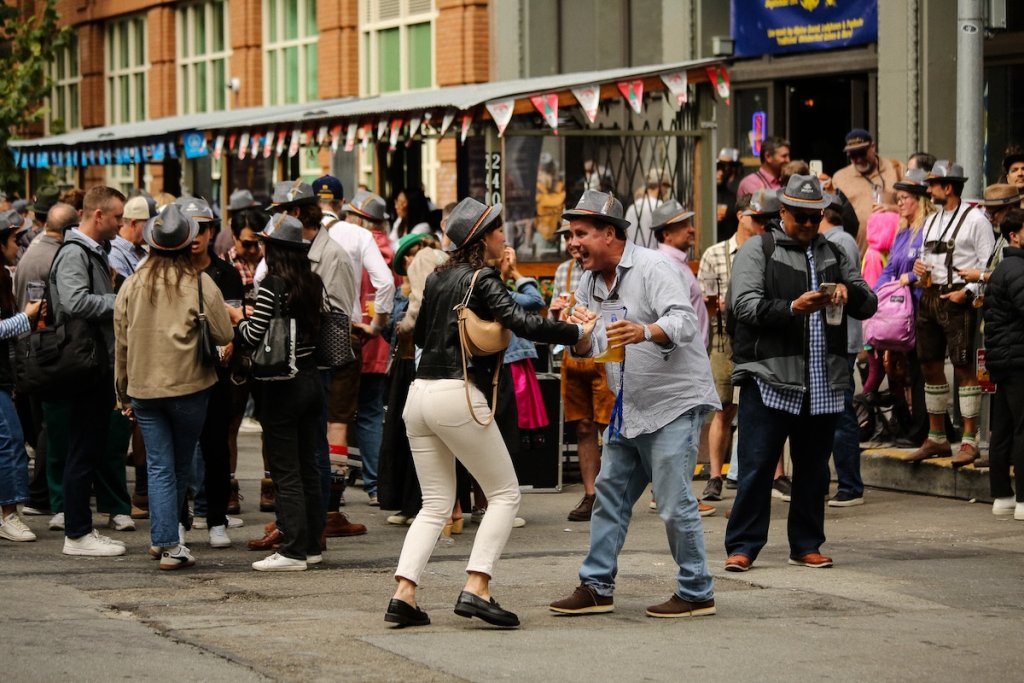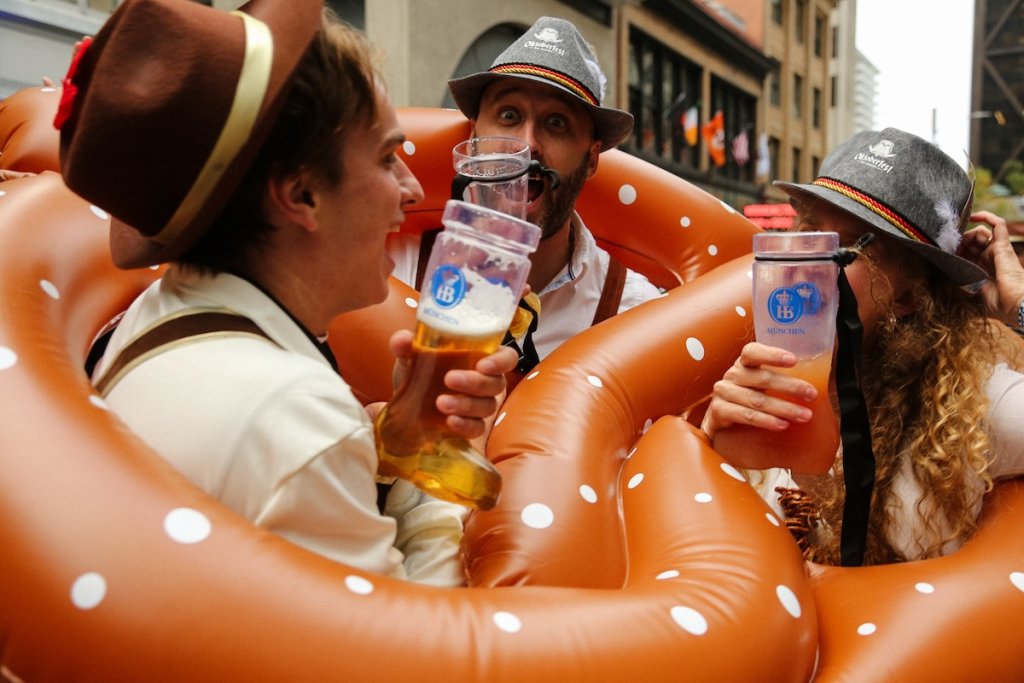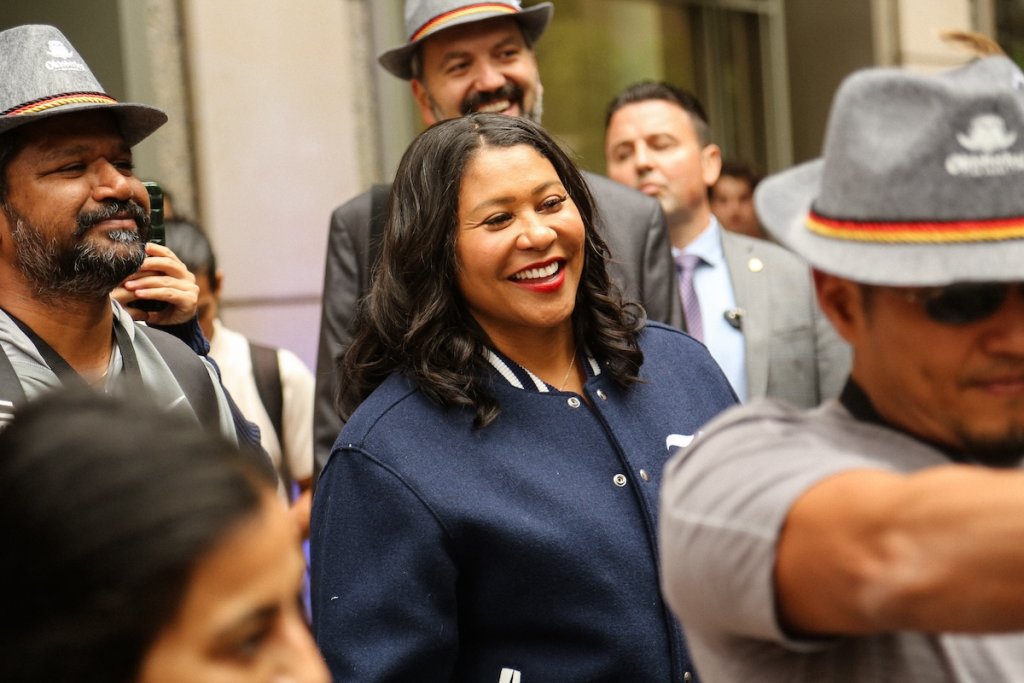In California, Michigan and Georgia, an easy win is bringing dollars — and delight — back to city centers.

Imagine a street once known for its vacant evenings — dim office lights, sidewalks mostly empty, the occasional clack of heels echoing off the streets. Now picture that same block pulsing with music, alive with laughter, and crowded with people swaying to a Celtic fiddle under strings of overhead lights. At the heart of it all, a server darts between tables with trays of food, as a group of Irish dancers spins in the middle of the street.
This was the scene on St. Patrick’s Day this year at St. Pat’s on Front, the fourth event in San Francisco’s newly launched Front Street Entertainment Zone, where thousands gathered to celebrate, dine, and rediscover downtown as a place to linger, not just pass through.
This scene is slowly becoming commonplace not just in San Francisco, California, but other municipalities in Michigan and Georgia, too — three states that have made it possible for cities to transform their streetscapes into thriving social districts. The key? A new legislative tool called Entertainment Zones that allows cities to create special zones where customers of restaurants, bars and other venues can leave the venue with open alcoholic beverages and enjoy them in the street during special events.
Rethinking the role of downtowns
Entertainment zones solve more than one problem. For years, downtown streets were natural gathering places, but decades of mono-economy stamped them with one purpose: office work. The symptom of this evolution was landscapes dominated by 9-to-5 workers, leaving many districts deserted after hours.
But the pandemic upended this dynamic, revealing an opportunity to redefine downtown as a vibrant social space once again, and San Francisco is living proof.

San Francisco’s Front Street served as the first testing ground for this legislation in California. In 2023, SB 76 was first introduced by Senator Scott Wiener to allow the City of San Francisco to create Entertainment Zones. The City’s Board of Supervisors voted to approve then-Mayor London Breed’s legislation to establish the framework for Front Street to pilot the concept, and for other San Francisco neighborhoods and eventually other cities to follow.
The legislation, paired with easier permitting processes, zoning flexibility, and infrastructure investments, has facilitated the development of public spaces. Cutting through the red tape to reduce bureaucratic hurdles and fees allows organizers to bring fresh and exciting experiences to the area without unnecessary hoops and delays.
Since launching last fall, the Front Street Entertainment Zone has drawn more than 21,000 attendees across its first four events and given a major boost to the street’s legacy bars and local businesses. For local favorite Schroeder’s, for example, a recent Oktoberfest event wasn’t just a celebration: it became the biggest special event in the restaurant’s history, with sales reaching up to ten times a typical Friday.
It wasn’t just good for business, either: it was a hit with the public too. According to a post-event survey, 95 percent of attendees said they came downtown specifically for Oktoberfest.


The impact of Front Street’s success was cited when Governor Newsom signed SB 969 into law, allowing Entertainment Zones to expand to other cities in California starting January 1, 2025. Currently, 20 additional areas in San Francisco have been designated for Entertainment Zones, and other California cities, including San Diego, Long Beach and many others are in talks to implement their own versions.
California’s experiment is part of a broader movement to redefine downtowns, with local organizations fighting to drive economic and inclusive regeneration. In cities like Grand Rapids, MI and Savannah, GA, similar zones have increased foot traffic and revenue by allowing food and beverage businesses to serve to-go drinks and activate their streets. Some cities also close streets to vehicles during events, prioritizing people over cars and turning underused blocks onto cultural destinations.
Grand Rapids launched its Downtown Refreshment Area in 2020 to support local restaurants and bars during COVID-19. Enabled by state legislation, the open-air district quickly became a draw, spanning nearly three square miles and boosting both foot traffic and sales.
More than 60 participating businesses have since expanded—proof of its popularity with locals and visitors alike. While Grand Rapids took a slightly different approach than San Francisco’s Front Street, both cities share a core goal: creating flexible, community-driven spaces that bring people together and breathe new life into downtown. It’s also proof that not every Entertainment Zone needs to feel like a block party. Some may come alive through quieter moments — live jazz spilling into the sidewalk at sunset or late-night hours that invite people to linger a little longer. Testing different formats and expanding operating hours can help each neighborhood discover what resonates most, creating a rhythm that fits the local beat.
A proven model
These successes in many states point to a larger truth: when given a reason and a space, people want to spend time downtown. Local businesses are making more revenue and serving more new customers than ever during open streets, making downtowns attractive destinations that people want to visit, not a place to avoid. The blueprint is clear: proactive policymaking, strategic public-private partnerships, and an unwavering commitment to making downtowns dynamic again. It is time to push for streamlined permitting, zoning flexibility, and infrastructure investments that facilitate the development of public spaces. It’s a proven model to help revive the city’s economic core with lively, engaging experiences that invite people to come together.
Yes, coordinating across city departments, managing crowd logistics, and ensuring equitable access to public space all demand thoughtful planning and steady collaboration. These kinds of efforts take time and care. But the momentum is real, and communities are increasingly engaged.
At their best, downtowns are places where people and commerce connect. By embracing ideas like Entertainment Zones, cities can transform their streets into places where people gather, businesses thrive, and communities feel stronger. With the right vision, every city can build a downtown that is not just surviving but thriving — a beacon of energy, culture, and opportunity. The time is now to save our downtowns. Let’s make it happen.
Robbie Silver is the President and CEO of the Downtown SF Partnership.

Planetizen Federal Action Tracker
A weekly monitor of how Trump’s orders and actions are impacting planners and planning in America.

Amtrak Cutting Jobs, Funding to High-Speed Rail
The agency plans to cut 10 percent of its workforce and has confirmed it will not fund new high-speed rail projects.

Chicago’s Ghost Rails
Just beneath the surface of the modern city lie the remnants of its expansive early 20th-century streetcar system.

The Growing Challenge of Orphan Oil Wells in America
Orphan oil wells—abandoned, undocumented, and often leaking methane—pose a widespread environmental and climate threat across the U.S., and finding them is just the beginning of a costly and urgent cleanup effort.

After a Six-Year Struggle, Tenants in Boston’s Mattapan Neighborhood Win Permanent Affordability
When a new owner imposed sharp rent hikes in 2018, tenants organized and fought back. Now, more than 300 housing units will be affordable for the foreseeable future. Here’s how the tenants made it happen.

DOT Officially Cancels California High-Speed Rail Funding
The Trump administration has repeatedly taken aim at the LA-to-Bay Area rail project, blaming Democratic leaders for cost overruns and delays.
Urban Design for Planners 1: Software Tools
This six-course series explores essential urban design concepts using open source software and equips planners with the tools they need to participate fully in the urban design process.
Planning for Universal Design
Learn the tools for implementing Universal Design in planning regulations.
Caltrans
City of Fort Worth
Mpact (founded as Rail~Volution)
City of Camden Redevelopment Agency
City of Astoria
City of Portland
City of Laramie





























